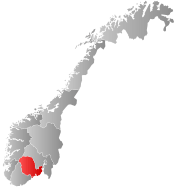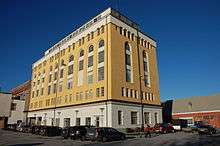Tinn
Tinn is a municipality in Telemark in the county of Vestfold og Telemark in Norway. It is part of the traditional regions of Upper Telemark and Øst-Telemark. The administrative centre of the municipality is the town of Rjukan.
Tinn kommune | |
|---|---|
Rjukan | |
 Coat of arms  Vestfold og Telemark within Norway | |
 Tinn within Vestfold og Telemark | |
| Coordinates: 60°0′33″N 8°33′34″E | |
| Country | Norway |
| County | Vestfold og Telemark |
| District | Aust-Telemark |
| Administrative centre | Rjukan |
| Area | |
| • Total | 2,045 km2 (790 sq mi) |
| • Land | 1,854 km2 (716 sq mi) |
| Area rank | 28 in Norway |
| Population (2006) | |
| • Total | 6,247 |
| • Rank | 155 in Norway |
| • Density | 3/km2 (8/sq mi) |
| • Change (10 years) | -5.6% |
| Demonym(s) | Tinndøl[1] |
| Time zone | UTC+01:00 (CET) |
| • Summer (DST) | UTC+02:00 (CEST) |
| ISO 3166 code | NO-3818 |
| Official language form | Neutral[2] |
| Website | www |
| UNESCO World Heritage Site | |
|---|---|
 The old ammonia factory at Notodden industrial site | |
| Criteria | Cultural: ii, iv |
| Reference | 1486 |
| Inscription | 2015 (39th session) |
| Area | 4,959.5 ha |
| Buffer zone | 33,967.6 ha |
The parish of Tin(d) was established as a municipality on 1 January 1838 (see formannskapsdistrikt). The area of Hovin was separated from the municipality of Tinn in 1860, but it was merged back into the municipality of Tinn on 1 January 1964.
Krossobanen is the oldest aerial tramway in Northern Europe. It was built in 1928 as a gift from Norsk Hydro. There is a museum and Hardangervidda National Park center at the lake Møsvatn close to Tinn.
General information
Name
The Old Norse form of the name was Tinnr. It is probably the old name of the Lake Tinn, the central lake in the municipality. The meaning of the name is unknown.[3]
Coat-of-arms
The coat-of-arms is from modern times. They were granted on 18 November 1994. The arms show five blue drops of water on a silver background. It was chosen to represent the five rivers in the municipality and the hydropower of Rjukan. It was designed by Halvor Holtskog.[4]
History
Rjukan Falls on the Måna river allowed construction of Vemork, the largest power station in the world in 1911. The station has become a museum where one can explore the history of the energy and see exhibits about the industrial development in Norway and at Rjukan, the municipality center of Tinn.
The museum is most famous for its presentation of Rjukan's war history. During World War II, Vemork was the site of the Norwegian heavy water sabotage, when Norwegian saboteurs prevented the Germans from producing nuclear weapons from the heavy water which was produced here. The exhibit Atomkappløpet ("The nuclear race") presents the four heavy water sabotages and the allied efforts to develop a nuclear bomb.
Geography
The municipality borders the municipality of Nore og Uvdal (in Buskerud county) to the north, Rollag and Flesberg (also in Buskerud) to the east, Notodden, Hjartdal, and Seljord to the south, and Vinje to the west.
Tinn stretches deeply into the Hardangervidda landscape. One landmark in Tinn is the 1,883 metres (6,178 ft) tall mountain Gaustatoppen, which is climbed by 30,000 people each year. On clear days it is possible to see one sixth of Norway from its summit.
References
- "Navn på steder og personer: Innbyggjarnamn" (in Norwegian). Språkrådet.
- "Forskrift om målvedtak i kommunar og fylkeskommunar" (in Norwegian). Lovdata.no.
- Rygh, Oluf (1914). Norske gaardnavne: Bratsbergs amt (dokpro.uio.no) (in Norwegian) (7 ed.). Kristiania, Norge: W. C. Fabritius & sønners bogtrikkeri. pp. 253–254.
- "Kommunevåpenet for Tinn". Tinn kommune. Retrieved 2017-09-23.
External links


- Municipal fact sheet from Statistics Norway

- Museum (in Norwegian)
- Postcard from Tinn
- Postmarks/cancels from Tinn

